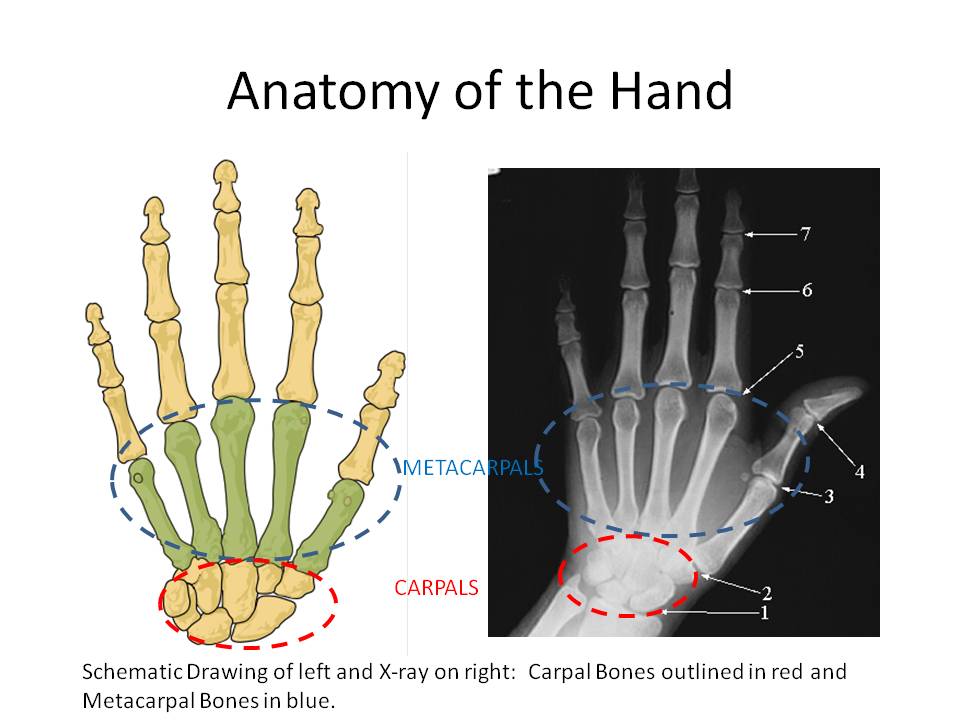Thumb Pain
Get Help With Thumb PainThumb pain can be disabling. A general understanding of the anatomy of the wrist and hand helps one understand possible sources of thumb pain.
There are many bones in the hand but for this discussion, we will limit it to two major groups: the carpals and metacarpals.
The carpals are eight small bones bound in two rows of four bones each.
The metacarpals are five in number and make up our palm region. They lie between the carpals and the fingers (phalanges).
The joint space between the carpal bones and the proximal base of the metacarpals make up the CMC (carpometacarpal) joint.
Thumb pain can occur when there is arthritis in the CMC joint. Other causes of thumb pain include tendonitis, DeQuervan’s tenosynovitis, peripheral neuropathy, peripheral nerve compression, brachial plexus injury, peripheral artery disease.
Non-surgical treatment options for CMC arthritis involve splinting, PT, rest, and NSAIDs. Surgical options include fusion or prosthetic replacement both of which are major surgeries with moderate to poor outcomes.
At the Centeno-Schultz Clinic, other options exist which include prolotherapy, PRP, and bone marrow concentrate injections.
Basal Joint Arthritis or CMC / Carpometacarpal Arthritis
The thumb is also referred to as the CMC joint. It is composed of two bones. The Carpal bone is denoted by the letter C. The second bone, the MC is the MetaCarpal bone. So your thumb is made up of the Carpal and MetaCarpal bones that come together and form a joint. The joint is lined with cartilage which allows the two bones to slide smoothly against one another. The thumb joint is held together by multiple thick ligaments. Ligaments are thick pieces of connective tissue that connect one bone to another. This joint is a saddle-shaped joint that experiences significant forces through activities of daily living.
Read More About Basal Joint Arthritis or CMC / Carpometacarpal ArthritisCarpal Tunnel Syndrome
The carpal tunnel is a tunnel-like structure in the wrist that the median nerve travels through. There are also carpal ligaments that form the roof of the tunnel and flexor tendons that also run through the tunnel. The median nerve is a branch that generates off the brachial plexus from the cervical spine in the neck. It stretches down through the arm, the wrist, and all the way into the thumb. The flexor tendons provide stability and help bend the thumb and fingers. When something causes the tunnel to narrow or the medial nerve somehow becomes compressed in the wrist, this can lead to carpal tunnel syndrome (CTS).
Read More About Carpal Tunnel SyndromeGuyon’s Canal
Guyon canal syndrome is a condition caused by the compression of the ulnar nerve as it passes through the Guyon canal, a narrow passageway located on the palm side of the wrist. This syndrome is commonly seen in people who perform repetitive tasks with their hands or use tools that vibrate, such as jackhammers or drills. Other causes of Guyon canal syndrome may include trauma or injury to the wrist, arthritis, or tumors. Treatment for Guyon canal syndrome may include immobilization of the wrist, anti-inflammatory medications, physical therapy, or– in severe cases– surgery. If left untreated, Guyon canal syndrome can lead to permanent nerve damage, muscle weakness, and loss of function in the affected hand and wrist.
Read More About Guyon’s CanalTFCC tear
TFCC stands for Triangular Fibrocartilage Complex. It’s basically a triangular-shaped spacer with ligaments that lives on the pinky finger (ulnar) side of your wrist (1). This complex of ligaments stabilizes the bones on that side and adds cushioning. The TFCC can become torn with a fall on an outstretched hand, other trauma, or just wear and tear. Instability is another feature of TFCC tears (2). The TFCC is part of an extensive group of ligaments that help stabilize both the small wrist bones and the ulna bone. If these become stretched and allow too much movement, this is called instability.
Read More About TFCC tearWrist Tendonitis
Wrist tendonitis, also known as tenosynovitis, is a condition characterized by inflammation of the tendons surrounding the wrist joint. This inflammation typically results from repetitive stress, overuse, or injury, causing the tendons to become irritated and swollen. Common contributing factors include activities that involve repetitive wrist movements, such as typing, manual labor, or sports-related motions. Additionally, sudden increases in activity level or improper ergonomics may play a role in the development of wrist tendonitis. As the tendons become inflamed, they can rub against the…
Read More About Wrist Tendonitis
